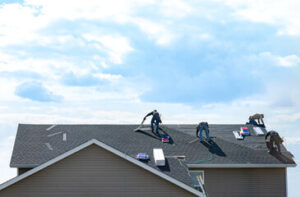Roofing is dangerous, so it’s a job best left to professionals who know what they are doing. When you re-roof, look for a material that will withstand your local climate, meet fire codes and look good.

A roof must be able to take an assault from wind, rain, snow, bitter cold and harsh sunlight year after year. It’s a big investment, so choose wisely. Visit https://www.northportflroofing.com to learn more.
A roof is an outer covering protecting the interior of a building from weather. Its construction depends on the nature of the supporting structure, availability of materials and an individual’s aesthetic preferences. The roof’s durability and energy efficiency are other important considerations. There are many roofing materials available on the market that range from natural products like thatch and slate to synthetic options like polycarbonate sheeting and rubber shingles. Some of these are low-slope materials that can be used on a flat roof, while others are better suited for steeper slopes.
Slate tiles are one of the most durable types of roofing material and provide a distinctive, layered look to a home. They can be costly and require maintenance but can last 50 years or more. Tiles are also fireproof and resistant to high winds, salty air and impact from hail or small branches. They can be purchased from a quarry or made synthetically by using fiber cement and bituminous styles.
Asphalt shingles are a popular and cost effective option for most homes and are available in several colors and styles to match your roof’s exterior. They are also a green roofing choice, as they are made from recycled tires and can be recycled at the end of their life cycle. These shingles are a good alternative to other more expensive options like wood shingle or slate and can be warranted for up to 30 years.
Metal shingles are another attractive and durable option that can be produced in different colours to match the roof’s existing colour scheme. They can be produced to look like slate or shingle and are also very durable, with some manufacturers offering warranties for up to 40 years.
Various types of membranes can be used on low-slope roofs including EPDM (ethylene propylene diene) rubber, PVC, TPO (thermoplastic polyolefin) and PU foam. Some of these are hot-applied and need to be heated to adhere properly while others use cold-applied adhesives that do not need to be heated beforehand. Some of these systems are also bonded to the surface of the roof and do not need underlayment.
Installation
While any part of your home can get assaulted by the elements (wind, rain, hail, bitter cold, intense heat, sharp sunlight), your roof takes the brunt of most of these insults. That’s why a well-installed, attractive roof is so worthwhile an investment.
Whether you’re roofing over an existing roof, replacing worn shingles, or reroofing a new construction, the first step is to remove the old materials. This typically involves pulling up shingles, old underlayment, and sheathing—plywood panels that provide a base for the new roof. You may also want to remove any metal flashing around chimneys, vents, or valleys in the roof.
Be sure to wear rubber-soled shoes, gloves, and eye protection. If you’re tackling this yourself, be particularly careful if the weather is wet or icy; working on a roof in these conditions can be downright dangerous. Choose a contractor who has experience with the type of roof you’re installing, and check to see if they’re credentialed by the manufacturer or have an active homeowners insurance policy.
Maintenance
Roofing, like all parts of the home exterior, gets assaulted by wind, rain, snow, hail, bitter cold and intense sunlight. It needs to withstand all this, year after year. The best way to keep your roof strong and in good shape is by performing periodic maintenance, ideally on an annual basis. For example, caulking around chimneys and other roof penetrations should be checked and replaced as needed to prevent water leaks. Also, tree branches should be trimmed so that they don’t scrape against the roof and weaken its structure. Finally, if water seeps under any flashing (the material that seals where different roofing planes meet) it should be replaced. These are simple, inexpensive tasks that will help keep your roofing strong and in good shape.